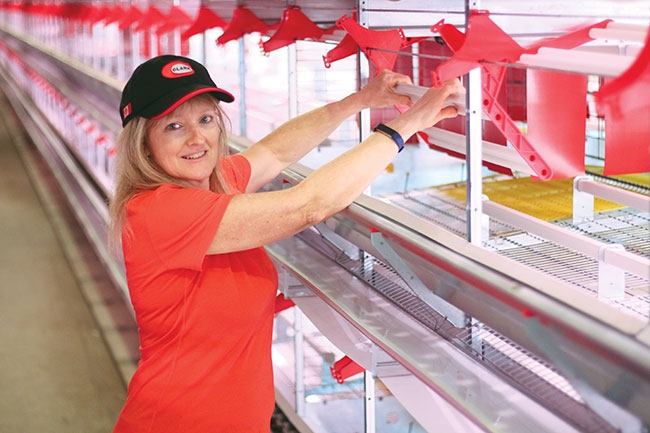
Alternative housing: Tips for a successful barn conversion
By Cindy Huitema
Features Blog Equipment Profiles Alternative poultry housing Animal Housing annex Barn construction Cage free Canada Cindy Egg Farmerette Egg production Livestock Production Ontario Phasing Out Conventional Poultry Production Production Profiles Success in Agriculture Egg farmer Cindy Huitema shares some key takeaways from her recently completed enriched barn build.
Egg farmer Cindy Huitema shares some key takeaways from her recently completed enriched barn build. Over the past year, I’ve been documenting my family’s journey converting from conventional housing to an enriched system on canadianpoultrymag.com. Thankfully, the new barn is up and running.
Based on our experience, my husband Nick and I compiled some key takeaways. While we installed enriched housing, the following tips could apply to any type of hen housing.
1. Start your research early
Begin researching at least two years in advance, as the actual building process will take a full year. Also, you need a Nutrient Management Plan before getting a building permit in Ontario. I suggest leaving yourself plenty of time for the permit process as I’ve found it can take a while.
2. Expect the unexpected
From the outset we made a month-by-month timeline. However, this went off kilter by our third month. Contractors can have a hard time committing to a timeline and this can often put you behind.
3. Avoid winter construction
We had issues getting our concrete work complete, which made some of our construction run into the winter months. Avoid this and plan to have the barn closed in by December, thus making it easier to do the inside work when outside temperatures turn frigid.
4. Hire reputable contractors
Find reputable contractors familiar with layer barn builds. This will save time as they will have done the type of work with farmers in the past with similar equipment.
5. Leverage technology
Make use of the most recent technologies and advancements in the industry. Our profession and the world of technology are always changing. Using what is most modern will help you to keep up. For instance, we decided to get in-house lighting in the enriched houses. This makes it easy for us to see the birds at hen care check time, saving us time and allowing us to see at a glance any issue that may have occurred since our last check. We still have lights on the ceiling as well for any maintenance and whenever we feel the need for more light.
6. Make use of contacts
Make use of industry contacts, such as feed salesmen, hatchery personnel, grading station experts and others. These people deal with farmers from a broad geographic region and can be a great resource. They can also give advice from outside of your particular farm situation and can be unbiased with input.
7. Build a contingency fund
You can have your budget and may have padded it some, but things always end up costing more than anticipated. This is partly due to unexpected or uncontrollable factors driving up costs. For instance, you cannot anticipate the weather. I never watched the weather so closely as I did this past year, especially in the winter. I was constantly checking to see what temperature the carpenter guys would be working in, whether it would be too cold for them to come, if the wind would hamper working conditions and other factors.
8. Prepare to be stressed
Be prepared for a year of doing more than your usual egg barn routine, working harder and having more stress as a result. Both Nick and I found the barn build interesting and exciting. However, my husband handled the stress a lot better than I did. Although both of us admit that we were overworked, overtired and outdone during portions of the build.
Cindy Huitema is an egg farmer from Haldimand County, Ont. In her now-concluded blog, she shared her journey transitioning from conventional hen housing to an enriched system.
Print this page